The Six-Legged Subject: A Survey of Secondary Science Teachers’ Incorporation of Insects into U.S. Life Science Instruction
Abstract
:1. Introduction
2. Materials and Methods
2.1. Survey Development
- Teacher demographics (8 items)
- Description of insect incorporation such as frequency or type of insect used (9 items)
- Barriers to incorporation (1 item)
- Teacher attitudes (2 items)
- Preferred resources to improve future incorporation (2 items)
- Perceived student benefit (1 item).
2.2. Participant Recruitment
2.3. Data Analysis
3. Results
3.1. Accuracy and Representativeness of Sample
3.2. Limitations
3.3. Description of Insect Incorporation in High School Biology Classrooms
3.4. Barriers to Incorporation
3.5. Teacher Attitudes
3.6. Preferred Resources
4. Discussion
4.1. Findings
4.2. Implications
4.3. Future Research Directions
5. Conclusions
Acknowledgments
Author Contributions
Conflicts of Interest
References
- Pedigo, L.P.; Rice, M.E. Entomology and Pest Management, 6th ed.; Pearson Prentice Hall: Upper Saddle River, NJ, USA, 2009; ISBN 978-0-13-513295-1. [Google Scholar]
- Triplehorn, C.A.; Johnson, N.F.; Borror, D.J. Borror and DeLong’s Introduction to the Study of Insects, 7th ed.; Thomson, Brooks/Cole: Belmont, CA, USA, 2005; ISBN 0-03-096835-6. [Google Scholar]
- Shipley, N.J.; Bixler, R.D. Beautiful bugs, bothersome bugs, and FUN bugs: Examining human interactions with insects and other arthropods. Anthrozoös 2017, 30, 357–372. [Google Scholar] [CrossRef]
- Kellert, S.R. Values and perceptions of invertebrates. Conserv. Biol. 1993, 7, 845–855. [Google Scholar] [CrossRef]
- Pearson, G.A.; Skinner, K.M.; Hoback, W.W. Rearing the Masses: Defining Competencies for Entomological Literacy. Am. Entomol. 2007, 53, 216–223. [Google Scholar] [CrossRef]
- Matthews, R.W.; Flage, L.R.; Matthews, J.R. Insects as teaching tools in primary and secondary education. Annu. Rev. Entomol. 1997, 42, 269–289. [Google Scholar] [CrossRef] [PubMed]
- Golick, D.A.; Heng-Moss, T.M. Insects as educational tools: An online course teaching the use of insects as instructional tools. Am. Entomol. 2013, 59, 183–187. [Google Scholar] [CrossRef]
- Golick, D.A.; Heng-Moss, T.M.; Ellis, M.D. Using insects to promote science inquiry in elementary classrooms. NACTA J. 2010, 54, 18–24. [Google Scholar]
- National Research Council. National Science Education Standards: Observe, Interact, Change, Learn; National Academy Press: Washington, DC, USA, 1996; ISBN 0-309-05326-9. [Google Scholar]
- NGSS Lead States. Next Generation Science Standards: For States, By States; National Academies Press: Washington, DC, USA, 2013. [Google Scholar]
- Ashbrook, P. Counting a culture of mealworms. Sci. Child. 2007, 45, 18–20. [Google Scholar]
- Hobbie, A. Making Connections with insect royalty. Green Teach. 2000, 10–17. [Google Scholar]
- Constible, J.; Lee, R.E. Awesome Aggregations. Sci. Teach. 2006, 73, 44–50. [Google Scholar]
- Terry, M. Art & Evolution. Sci. Teach. 2005, 72, 22–25. [Google Scholar]
- Gates, D.M. Creating caddisfly cases. Sci. Scope 2005, 29, 54–56. [Google Scholar]
- Damonte, K. Exploring insect vision. Sci. Child. 2005, 42, 47–48. [Google Scholar]
- White, H. Going Buggy. Sch. Art Educ. Mag. Teach. 2009, 108, 44. [Google Scholar]
- Travis, H. Pheromone caterpillar trails: An easy lab exercise for the classroom. Am. Biol. Teach. 2003, 65, 456–461. [Google Scholar] [CrossRef]
- Newell, S.J. Occurrence of goldenrod galls: Study of insect ovipositing behavior. Am. Biol. Teach. 1994, 56, 51–54. [Google Scholar] [CrossRef]
- Eason, P.K.; LaManna, M.M. Testing folklore in the lab: Can common plants be used to repel insect pests? Am. Biol. Teach. 2000, 62, 448–452. [Google Scholar] [CrossRef]
- Bowen, M.G. Investigating Crickets: Observing Animal Exploratory Behavior. Sci. Act. Classr. Proj. Curric. Ideas 2008, 45, 17–21. [Google Scholar] [CrossRef]
- Ashbrook, P. Collards and Caterpillars. Sci. Child. 2007, 44, 18–20. [Google Scholar]
- Biggs, D.; Miller, T.; Hall, D. There’s life in those dead logs! Sci. Child. 2006, 43, 36–41. [Google Scholar]
- Gates, D.M. Pond life magnified. Sci. Scope 2002, 25, 10–13. [Google Scholar]
- Halverson, K.L.; Lankford, D.M. Science galls me: What is a niche anyway? Am. Biol. Teach. 2009, 71, 483–491. [Google Scholar] [CrossRef]
- Hevel, G. How do insects help the environment? Sci. Child. 2005, 42, 44–45. [Google Scholar]
- Huss, J.; Baker, C. The Farmer in the Lab. Sci. Child. 2010, 47, 40–43. [Google Scholar]
- Shepardson, D.P. Bugs, butterflies, and spiders: Children’s understandings about insects. Int. J. Sci. Educ. 2002, 24, 627–643. [Google Scholar] [CrossRef]
- Shepardson, D.P. Of butterflies and beetles: First graders’ ways of seeing and talking about insect life cycles. J. Res. Sci. Teach. 1997, 34, 873–889. [Google Scholar] [CrossRef]
- Killermann, W. Research into biology teaching methods. J. Biol. Educ. 1998, 33, 4–9. [Google Scholar] [CrossRef]
- Sammet, R.; Dreesmann, D. What Do Secondary Students Really Learn during Investigations with Living Animals? Parameters for Effective Learning with Social Insects. J. Biol. Educ. 2017, 51, 26–43. [Google Scholar] [CrossRef]
- Aschbacher, P.R.; Ing, M.; Tsai, S.M. Is science me? Exploring middle school students’ STE-M career aspirations. J. Sci. Educ. Technol. 2014, 23, 735–743. [Google Scholar] [CrossRef]
- Osborne, J.; Simon, S.; Collins, S. Attitudes towards science: A review of the literature and its implications. Int. J. Sci. Educ. 2003, 25, 1049–1079. [Google Scholar] [CrossRef]
- National Academy of Sciences; National Academy of Engineering. Rising Above the Gathering Storm: Energizing and Employing America for a Brighter Economic Future; National Academy Press: Washington, DC, USA, 2005; ISBN 978-0-309-18758-9. [Google Scholar]
- Barmby, P.; Kind, P.M.; Jones, K. Examining changing attitudes in secondary school science. Int. J. Sci. Educ. 2008, 30, 1075–1093. [Google Scholar] [CrossRef] [Green Version]
- Wang, H.-H.; Bhattacharya, D.; Evans, E.; Jirik, P. Building Bee Houses: Designing and Constructing Solitary Bee Houses for Scientific Investigations. Sci. Scope 2017, 41, 41–49. [Google Scholar] [CrossRef]
- Golick, D.A.; Ellis, M.D.; Beecham, B. Creating & Evaluating Artificial Domiciles for Bumble Bees. Am. Biol. Teach. 2006, 68, e29–e34. [Google Scholar] [CrossRef]
- Dillman, D.A. Internet, Mail, and Mixed-Mode Surveys: The Tailored Design Method, 3rd ed.; Wiley & Sons: Hoboken, NJ, USA, 2009; ISBN 978-0-471-69868-5. [Google Scholar]
- Blank, R.; Langesen, D.; Petermann, A. State Indicators of Science and Mathematics Education; Council of Chief State School Officers: Washington, DC, USA, 2007. [Google Scholar]
- U.S. Department of Education, National Center for Educational Statistics. Table 209.50. Percentage of Public School Teachers of Grades 9 through 12, by Field of Main Teaching Assignment and Selected Demographic and Educational Characteristics: 2011–12; Digest of Education Statistics; U.S. Department of Education: Washington, DC, USA, 2015; p. 158.
- U.S. Department of Education, National Center for Educational Statistics. Table 105.50. Number of Educational Institutions, by Level and Control of Institution: Selected Years, 1980–81 through 2013–14; Digest of Education Statistics; U.S. Department of Education: Washington, DC, USA, 2015; p. 62.
- Every Student Succeeds Act; U.S. Government Publishing Office: Washington, DC, USA, 2015.
- Wagler, R.; Wagler, A. Arthropods: Attitude and incorporation in preservice elementary teachers. Int. J. Environ. Sci. Educ. 2011, 6, 229–250. [Google Scholar]
- Wagler, R.; Wagler, A. External insect morphology: A negative factor in attitudes toward insects and likelihood of incorporation in future science education settings. Int. J. Environ. Sci. Educ. 2012, 7, 313–325. [Google Scholar]
- American Association for the Advancement of Science. Science for All Americans: A Project 2061 Report on Literacy Goals in Science, Mathematics, and Technology; American Association for the Advancement of Science: Washington, DC, USA, 1989; Volume 1, p. 2061. [Google Scholar]
- Loucks-Horsley, S. Designing Professional Development for Teachers of Science and Mathematics; Corwin Press: Thousand Oaks, CA, USA, 2010; ISBN 978-1-4129-7414-1. [Google Scholar]
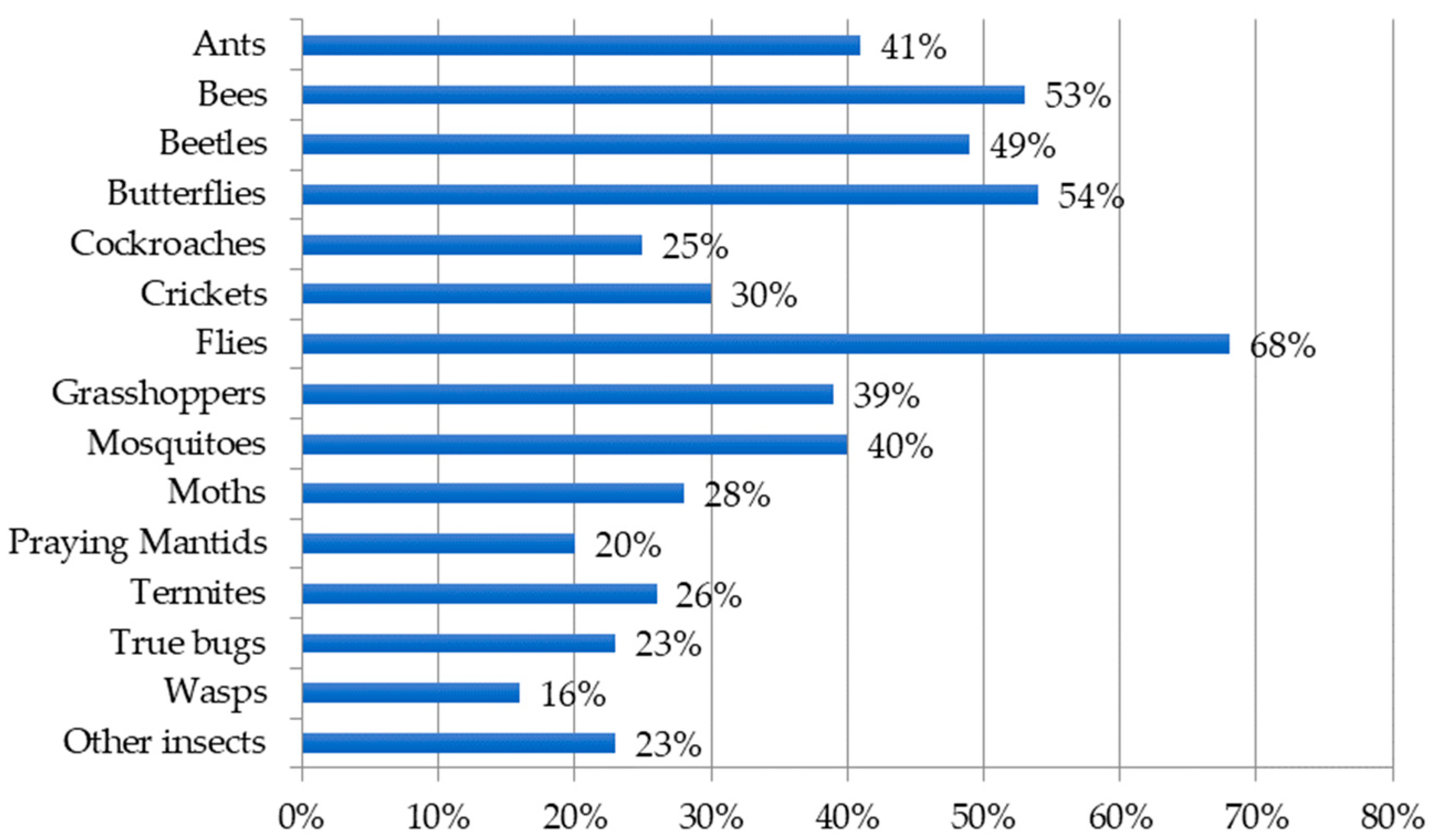
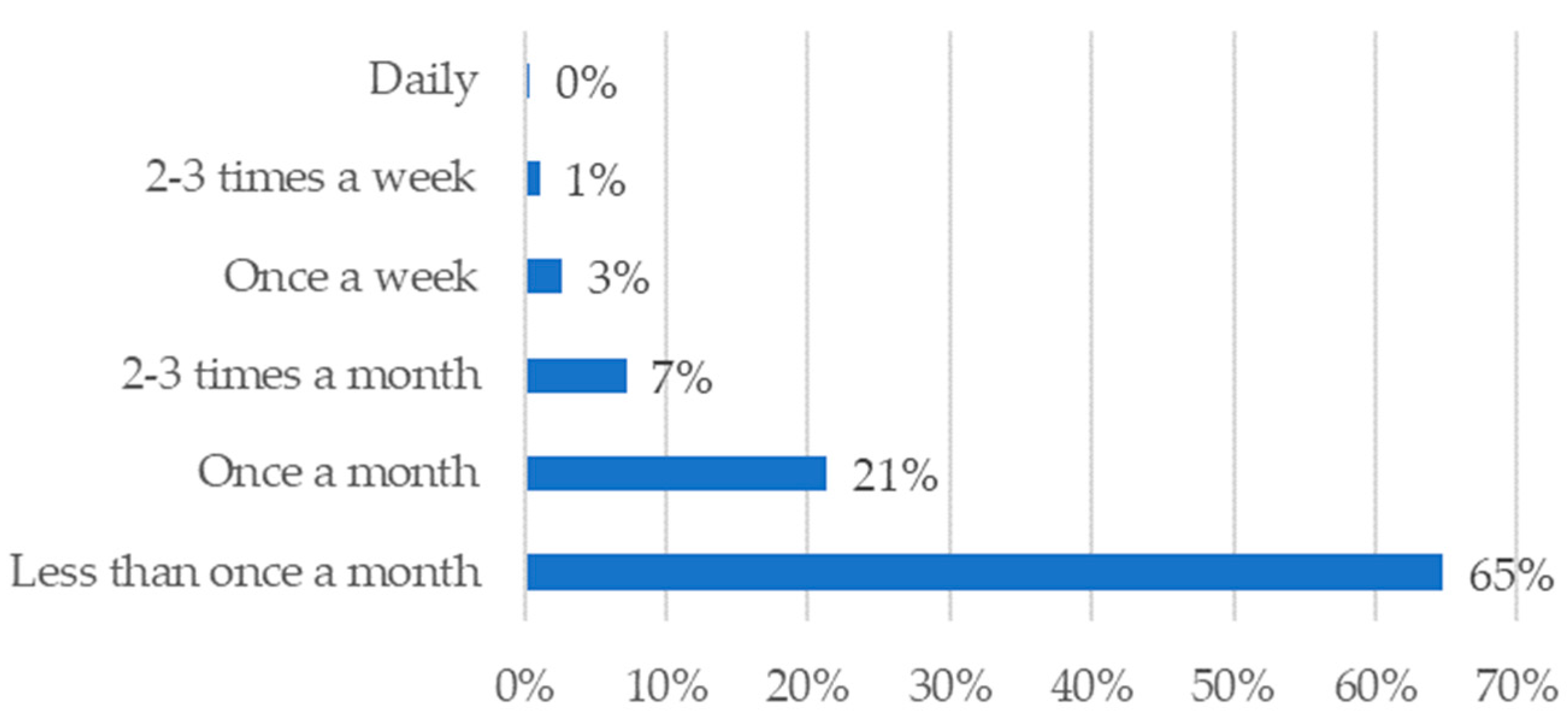
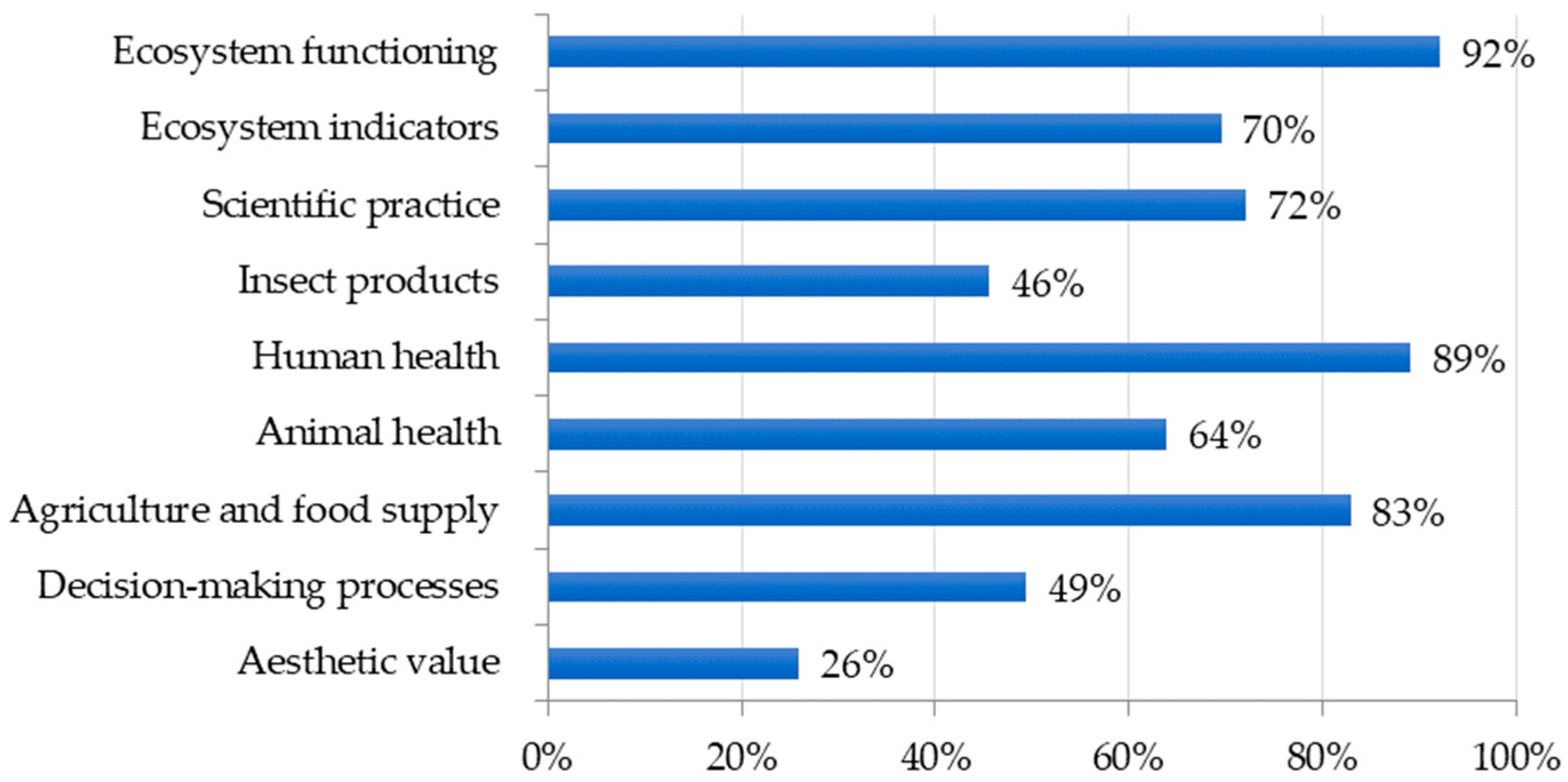
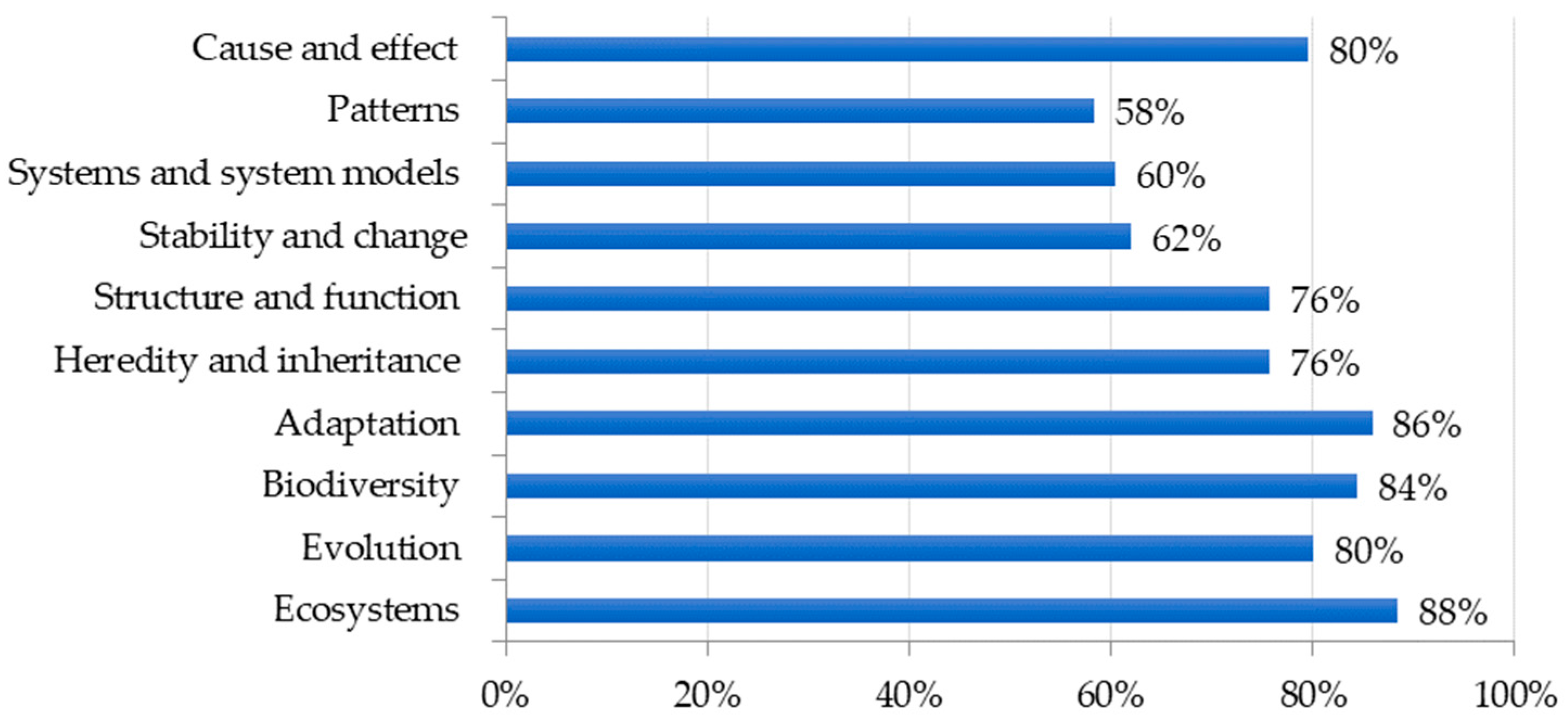
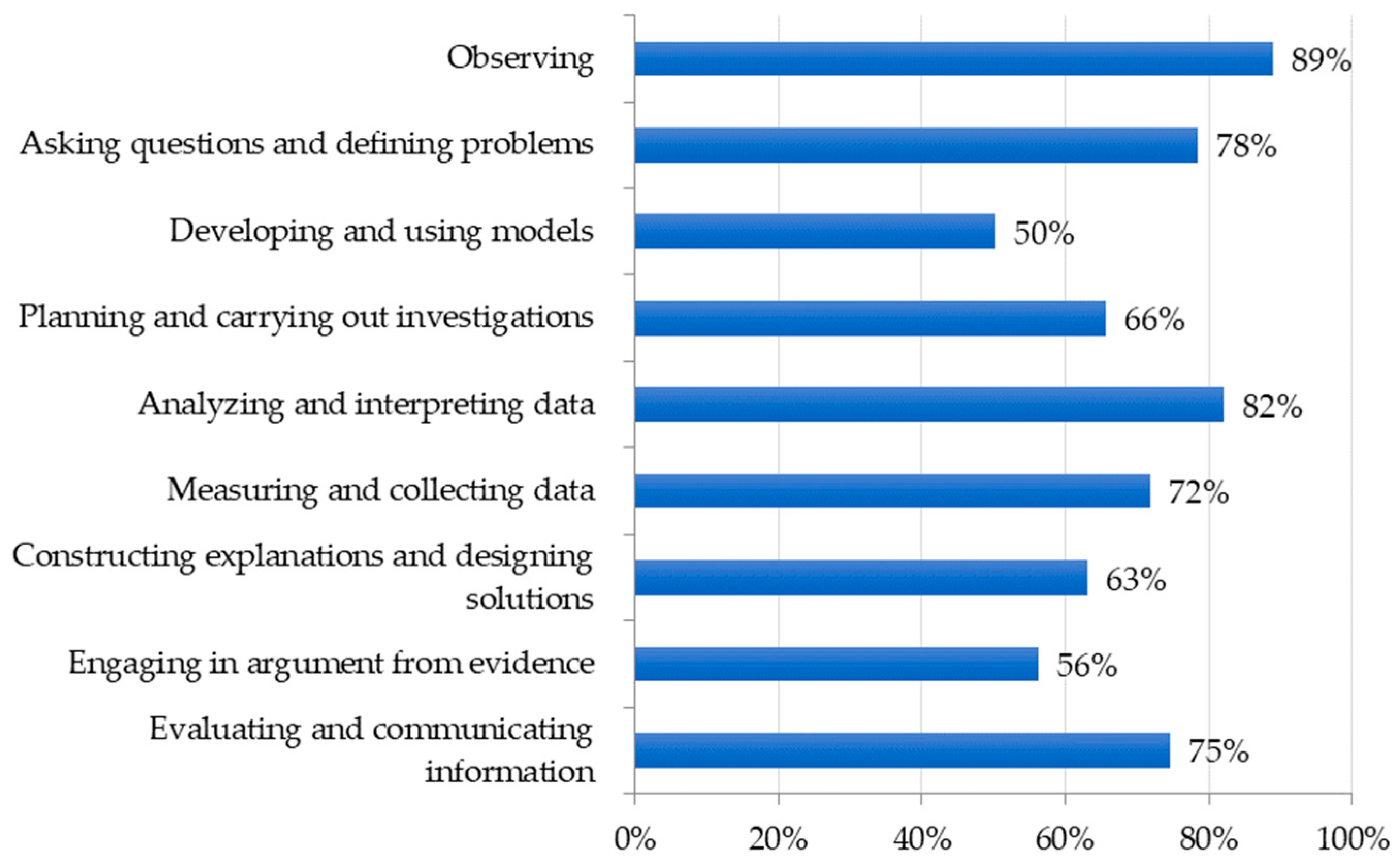
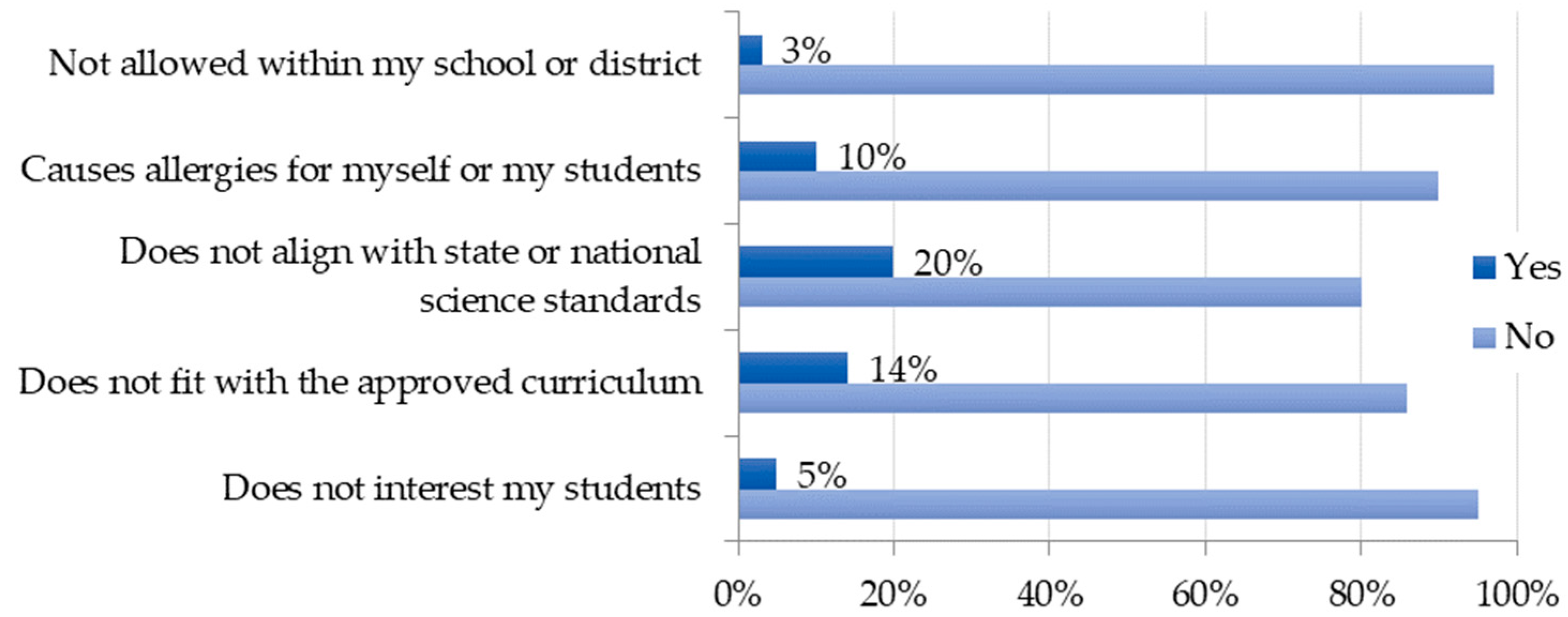

| Demographic Type | Demographic Criteria | Demographic Characteristics | National Natural Science Teacher Population | Survey Sample | n | Difference |
|---|---|---|---|---|---|---|
| Teacher Demographics | Gender | Male | 45% | 38% | 84 | −7% |
| Female | 55% | 62% | 135 | 7% | ||
| Age | Under 30 | 16% | 6% | 13 | −10% | |
| 30–39 | 30% | 21% | 46 | −9% | ||
| 40–49 | 26% | 29% | 64 | 3% | ||
| 50–59 | 22% | 33% | 73 | 11% | ||
| 60 and over | 7% | 11% | 23 | 4% | ||
| Years Teaching | <3 years | 10% | 6% | 11 | −4% | |
| 3–9 | 34% | 15% | 29 | −19% | ||
| 10–20 | 36% | 44% | 86 | 8% | ||
| >20 years | 21% | 35% | 68 | 14% | ||
| Degree Earned | <Bachelors | 3% | 0% | 0 | −3% | |
| Bachelors | 36% | 28% | 61 | −8% | ||
| Masters | 52% | 64% | 139 | 12% | ||
| Doctorate | 4% | 7% | 15 | 3% | ||
| Education Specialist | 6% | 2% | 4 | −4% | ||
| School Demographics | Locale | City | 26% | 23% | 48 | −3% |
| Suburb | 27% | 38% | 81 | 9% | ||
| Town | 14% | 14% | 29 | 0% | ||
| Rural | 32% | 26% | 54 | −6% | ||
| Public/Private Designation | Public | 75% | 87% | 181 | +12% | |
| Private | 25% | 13% | 27 | −12% |
| Rank | Resource | Mean Rank ± SE |
|---|---|---|
| 1 | Lesson plans aligned with standards | 2.61 ± 0.122 |
| 2 | Professional development on using insects in inquiry | 2.64 ± 0.111 |
| 3 | Professional entomologists visiting the classroom | 3.75 ± 0.123 |
| 4 | Live insects available for check-out | 3.78 ± 0.106 |
| 5 | Insect collecting supplies available for check-out | 4.00 ± 0.099 |
| 6 | Guide on insect care | 4.22 ± 0.104 |
© 2018 by the authors. Licensee MDPI, Basel, Switzerland. This article is an open access article distributed under the terms and conditions of the Creative Commons Attribution (CC BY) license (http://creativecommons.org/licenses/by/4.0/).
Share and Cite
Ingram, E.; Golick, D. The Six-Legged Subject: A Survey of Secondary Science Teachers’ Incorporation of Insects into U.S. Life Science Instruction. Insects 2018, 9, 32. https://doi.org/10.3390/insects9010032
Ingram E, Golick D. The Six-Legged Subject: A Survey of Secondary Science Teachers’ Incorporation of Insects into U.S. Life Science Instruction. Insects. 2018; 9(1):32. https://doi.org/10.3390/insects9010032
Chicago/Turabian StyleIngram, Erin, and Douglas Golick. 2018. "The Six-Legged Subject: A Survey of Secondary Science Teachers’ Incorporation of Insects into U.S. Life Science Instruction" Insects 9, no. 1: 32. https://doi.org/10.3390/insects9010032





